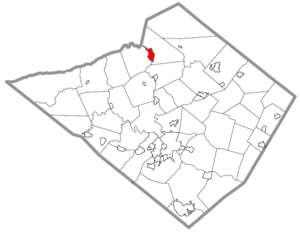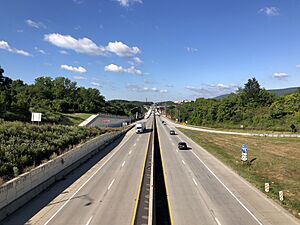Hamburg, Pennsylvania facts for kids
Quick facts for kids
Hamburg, Pennsylvania
Hambarig
|
|
|---|---|

Aerial view of Hamburg
|
|

Location of Hamburg in Berks County, Pennsylvania
|
|
| Country | United States |
| State | Pennsylvania |
| County | Berks |
| Area | |
| • Total | 1.96 sq mi (5.08 km2) |
| • Land | 1.89 sq mi (4.89 km2) |
| • Water | 0.07 sq mi (0.19 km2) |
| Elevation | 397 ft (121 m) |
| Population
(2020)
|
|
| • Total | 4,270 |
| • Density | 2,262.85/sq mi (873.50/km2) |
| Time zone | UTC-5 (EST) |
| • Summer (DST) | UTC-4 (EDT) |
| ZIP Code |
19526
|
| Area codes | 610 and 484 |
| FIPS code | 42-32120 |
Hamburg is a small town, also known as a borough, located in Berks County, Pennsylvania. In 2020, about 4,270 people lived here. The town's name, Hambarig in Pennsylvania German, is thought to come from Hamburg, Germany. However, it might actually be named after Bad Homburg, another place in Germany.
Contents
Where is Hamburg? (Geography)
Hamburg is in the northern part of Berks County. It sits on the east side of the Schuylkill River. To the north, east, and south, it's next to Windsor Township. Across the river to the west is West Hamburg, which is in Tilden Township.
The town covers about 1.96 square miles (5.0 square kilometers). Most of this area is land, with a small part being water, like the river.
Hamburg's Weather (Climate)
Hamburg has a climate where summers are hot and winters are cold, but not extremely dry. This is called a humid continental climate. The average temperature in January is around 28.4°F, and in July, it's about 73.4°F.
| Climate data for Hamburg, Pennsylvania (1991–2020 normals, extremes 1894–present) | |||||||||||||
|---|---|---|---|---|---|---|---|---|---|---|---|---|---|
| Month | Jan | Feb | Mar | Apr | May | Jun | Jul | Aug | Sep | Oct | Nov | Dec | Year |
| Record high °F (°C) | 69 (21) |
78 (26) |
88 (31) |
95 (35) |
97 (36) |
102 (39) |
107 (42) |
103 (39) |
100 (38) |
89 (32) |
80 (27) |
75 (24) |
107 (42) |
| Mean daily maximum °F (°C) | 37.7 (3.2) |
40.6 (4.8) |
49.9 (9.9) |
62.5 (16.9) |
72.6 (22.6) |
80.9 (27.2) |
85.3 (29.6) |
83.1 (28.4) |
76.1 (24.5) |
64.3 (17.9) |
52.6 (11.4) |
42.0 (5.6) |
62.3 (16.8) |
| Daily mean °F (°C) | 28.8 (−1.8) |
31.2 (−0.4) |
39.9 (4.4) |
51.1 (10.6) |
61.4 (16.3) |
70.3 (21.3) |
74.8 (23.8) |
72.8 (22.7) |
65.4 (18.6) |
53.4 (11.9) |
42.9 (6.1) |
33.8 (1.0) |
52.1 (11.2) |
| Mean daily minimum °F (°C) | 20.0 (−6.7) |
21.9 (−5.6) |
30.0 (−1.1) |
39.8 (4.3) |
50.3 (10.2) |
59.6 (15.3) |
64.4 (18.0) |
62.5 (16.9) |
54.7 (12.6) |
42.4 (5.8) |
33.2 (0.7) |
25.6 (−3.6) |
42.0 (5.6) |
| Record low °F (°C) | −20 (−29) |
−13 (−25) |
−1 (−18) |
10 (−12) |
28 (−2) |
35 (2) |
37 (3) |
39 (4) |
30 (−1) |
17 (−8) |
6 (−14) |
−10 (−23) |
−20 (−29) |
| Average precipitation inches (mm) | 3.45 (88) |
2.73 (69) |
3.70 (94) |
3.72 (94) |
4.08 (104) |
4.96 (126) |
5.15 (131) |
4.92 (125) |
5.09 (129) |
4.47 (114) |
3.32 (84) |
3.89 (99) |
49.48 (1,257) |
| Average snowfall inches (cm) | 5.1 (13) |
7.1 (18) |
4.6 (12) |
0.3 (0.76) |
0.0 (0.0) |
0.0 (0.0) |
0.0 (0.0) |
0.0 (0.0) |
0.0 (0.0) |
0.0 (0.0) |
0.5 (1.3) |
3.7 (9.4) |
21.3 (54) |
| Average precipitation days (≥ 0.01 in) | 11.1 | 9.1 | 10.4 | 12.0 | 13.7 | 12.3 | 11.4 | 11.3 | 10.2 | 11.2 | 9.3 | 10.6 | 132.6 |
| Average snowy days (≥ 0.1 in) | 4.3 | 3.6 | 2.1 | 0.1 | 0.0 | 0.0 | 0.0 | 0.0 | 0.0 | 0.0 | 0.4 | 2.0 | 12.5 |
| Source: NOAA | |||||||||||||
Who Lives in Hamburg? (Demographics)
| Historical population | |||
|---|---|---|---|
| Census | Pop. | %± | |
| 1800 | 329 | — | |
| 1830 | 560 | — | |
| 1850 | 1,035 | — | |
| 1860 | 1,334 | 28.9% | |
| 1870 | 1,590 | 19.2% | |
| 1880 | 2,010 | 26.4% | |
| 1890 | 2,127 | 5.8% | |
| 1900 | 2,315 | 8.8% | |
| 1910 | 2,301 | −0.6% | |
| 1920 | 2,764 | 20.1% | |
| 1930 | 3,637 | 31.6% | |
| 1940 | 3,717 | 2.2% | |
| 1950 | 3,805 | 2.4% | |
| 1960 | 3,747 | −1.5% | |
| 1970 | 3,909 | 4.3% | |
| 1980 | 4,011 | 2.6% | |
| 1990 | 3,987 | −0.6% | |
| 2000 | 4,114 | 3.2% | |
| 2010 | 4,289 | 4.3% | |
| 2020 | 4,270 | −0.4% | |
| Sources: | |||
In 2000, Hamburg had 4,114 people living in 1,824 households. About 25.7% of these households had children under 18. Many families were married couples living together.
The population included people of all ages. About 21.1% were under 18, and 20.6% were 65 or older. The average age in Hamburg was 40 years old.
Hamburg's Past (History)
Hamburg started in 1779 when Martin Kaercher Jr. divided his land into building lots. He called the area "Kaercher Stadt." The town was officially founded in 1787. People often think it was named after Hamburg, Germany, because many German people lived there. However, it's more likely that the name came from Bad Homburg, a town in Germany that looks similar to the Blue Mountains nearby.
Hamburg became the second town in Berks County to have a post office in 1798. In 1812, the Centre Turnpike, a major road, was built nearby. This helped Hamburg grow quickly. Later, the Schuylkill Canal and railroad lines were built, both with stops in Hamburg. These transportation links helped the town's population increase even more.
In 1837, Hamburg officially became a borough. Today, you can visit important historical places like the Hamburg Historic District, the Hamburg Armory, and the Hamburg Public Library. These places are listed on the National Register of Historic Places.
Learning in Hamburg (Education)
The Hamburg Area School District is the biggest school district in Berks County. It covers about 103 square miles (267 square kilometers). Around 2,600 students attend schools here, from kindergarten all the way to high school. The district includes Hamburg, Shoemakersville, and several nearby rural townships.
There are two elementary schools for students in grades K-5. After elementary school, all students go to one middle school for grades 6-8. Then, they attend one high school for grades 9-12. Both the middle and high schools are located in Hamburg, very close to each other. There's also a private high school nearby called Blue Mountain Academy.
Many churches in the Hamburg area offer Sunday or Sabbath school services. Some of these churches also have preschool programs for younger children.
Getting Around Hamburg (Transportation)
Hamburg has about 24.49 miles (39.41 km) of public roads. Some are managed by the state, and others by the borough itself.
The Interstate 78 and U.S. Route 22 freeway goes through Hamburg. You can get on or off at Exit 30 (North 4th Street). This highway connects Hamburg to Allentown (about 28 miles west) and Harrisburg (about 54 miles east). Pennsylvania Route 61 also passes through the southern part of town, leading to Reading and Pottsville.
You can also travel by bus! Berks Area Regional Transportation Authority (BARTA) has a bus route that goes from Hamburg to Reading. There's a place to park your car and catch the bus at the Redner's in Hamburg. Another bus service, Schuylkill Transportation System, goes north from Hamburg to Pottsville.
In the past, Hamburg had passenger train service to Reading, Philadelphia, and Pottsville. This service stopped in 1981. Today, the Reading Blue Mountain and Northern Railroad provides freight train service to Hamburg.
Fun Things to Do (Attractions)
The Reading Railroad Heritage Museum is a cool place to visit in Hamburg. It's all about the history of the Reading Railroad. You can see a permanent model train setup and even some real train cars from before 1976. The museum is open on Saturdays and Sundays all year round.
Famous People from Hamburg (Notable people)
- Bill Beckley – a well-known artist
- Richard Etchberger – a member of the United States Air Force who received the Medal of Honor
- Jack Rowe – a professional baseball player
- Fern Shollenberger – a professional baseball player
See also
 In Spanish: Hamburg (Pensilvania) para niños
In Spanish: Hamburg (Pensilvania) para niños




